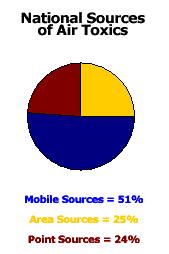POINT SOURCES, or MAJOR SOURCES, are stationary sources that emit 10 tons per year of a single air toxic pollutant or 25 tons per year of any combination of air toxics as defined in the Clean Air Act (CAA).
NONPOINT SOURCES, or AREA SOURCES, are stationary sources of emissions that are too small and diffuse to be inventoried as individual sources. Area sources are defined as sources that emit less than 10 tons per year of a single air toxic, or less than 25 tons per year of a mixture of air toxics. Examples include neighborhood dry cleaners and gas stations. Although emissions from individual area sources are often relatively small, collectively their emissions can be quite significant.
MOBLE SOURCES are not fixed at one location and can be either ON ROAD or NON ROAD sources.
The ON ROAD SOURCES category includes all vehicles registered to use the public roadways(i.e. automobiles, trucks, and buses).
The NON ROAD SOURCES category includes vehicles and equipment that normally do not provide transportation on public roads (i.e., lawn and garden equipment, recreational equipment including recreational marine equipment). Also included in this category are aircraft, commercial marine vessel, and locomotive sources.
AIRCRAFT SOURCES are general aviation and air taxis aircraft.
The COMMERCIAL MARINE VESSEL (CMV) AND LOCOMOTIVE MOBILE SOURCES includes all boats and ships used either directly or indirectly in the conduct of commerce or military activity and all locomotive powered by diesel-electric engines.

Source: EPA Air Toxics (PDF 446 KB)
